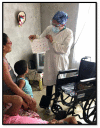Pediatric Oncology Palliative Care Programs in Central America: Pathways to Success
- PMID: 34828744
- PMCID: PMC8624815
- DOI: 10.3390/children8111031
Pediatric Oncology Palliative Care Programs in Central America: Pathways to Success
Abstract
Palliative care offers children who have life-limiting and life-threatening oncologic illnesses and their families improved quality of life. In some instances, impeccable symptom control can lead to improved survival. Cultural and financial barriers to palliative care in oncology patients occur in all countries, and those located in Central America are no exception. In this article, we summarize how the programs participating in the Asociación de Hemato-Oncólogos Pediatras de Centro America (AHOPCA) have developed dedicated oncology palliative care programs. The experience in Guatemala, El Salvador, Costa Rica, Panama, Dominican Republic and Haiti is detailed, with a focus on history, the barriers that have impeded progress, and achievements. Future directions, which, of course, may be impacted by the COVID-19 pandemic, are described as well.
Keywords: pain; palliative care; pediatric oncology.
Conflict of interest statement
The authors declare no conflict of interest.
Figures





References
-
- Knaul F.M., Farmer P.E., Krakauer E.L., De Lima L., Bhadelia A., Jiang Kwete X., Arreola-Ornelas H., Gómez-Dantés O., Rodriguez N.M., Alleyne G.A.O., et al. Alleviating the access abyss in palliative care and pain relief—an imperative of universal health coverage: The Lancet Commission report. Lancet. 2018;391:1391–1454. doi: 10.1016/S0140-6736(17)32513-8. - DOI - PubMed
-
- World Health Organization (WHO) Global Atlas of Palliative Care at the End of Life. 2014. [(accessed on 20 February 2021)]. Available online: https://www.who.int/nmh/Global_Atlas_of_Palliative_Care.pdf.
-
- Connor S. Global Atlas of Palliative Care. 2nd ed. Worldwide Hospice Palliative Care Alliance; London, UK: 2020.
Publication types
LinkOut - more resources
Full Text Sources

